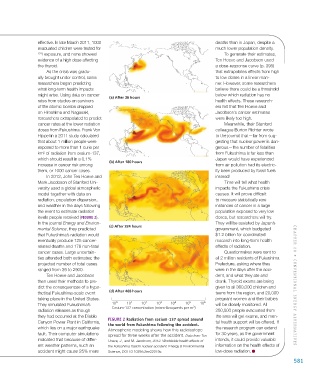Page 582 - Environment: The Science Behind the Stories
P. 582
effective. In late March 2011, 1000 deaths than in Japan, despite a
evacuated children were tested for much lower population density.
131 I exposure, and none showed To generate their estimates,
evidence of a high dose affecting Ten Hoeve and Jacobson used
the thyroid. a dose-response curve (p. 395)
As the crisis was gradu- that extrapolates effects from high
ally brought under control, some to low doses in a linear man-
researchers began predicting ner. However, some researchers
what long-term health impacts believe there could be a threshold
might arise. Using data on cancer (a) After 36 hours below which radiation has no
rates from studies on survivors health effects. These research-
of the atomic bombs dropped ers felt that Ten Hoeve and
on Hiroshima and Nagasaki, Jacobson’s cancer estimates
researchers extrapolated to predict were likely too high.
cancer rates at the lower radiation Meanwhile, their Stanford
doses from Fukushima. Frank Von colleague Burton Richter wrote
Hippel in a 2011 study calculated to the journal that—far from sug-
that about 1 million people were gesting that nuclear power is dan-
exposed to more than 1 curie per gerous—the number of fatalities
2
km of radiation from cesium-137, from Fukushima is far less than
which should result in a 0.1% Japan would have experienced
increase in cancer risk among (b) After 180 hours from air pollution had its electric-
them, or 1000 cancer cases. ity been produced by fossil fuels
In 2012, John Ten Hoeve and instead!
Mark Jacobson of Stanford Uni- Time will tell what health
versity used a global atmospheric impacts the Fukushima crisis
model together with data on causes. It will prove difficult
radiation, population dispersion, to measure statistically rare
and weather in the days following instances of cancer in a large
the event to estimate radiation population exposed to very low
levels people received (FIGURE 2). doses, but researchers will try.
In the journal Energy and Environ- They will be assisted by Japan’s
mental Science, they predicted (c) After 324 hours government, which budgeted
that Fukushima’s radiation would $1.2 billion for coordinated
eventually produce 125 cancer- research into long-term health
related deaths and 178 non-fatal effects of radiation.
cancer cases. Large uncertain- Questionnaires were sent to
ties attended both estimates; the all 2 million residents of Fukushima
projected number of total cases Prefecture, asking where they
ranged from 39 to 2900. were in the days after the acci-
Ten Hoeve and Jacobson dent, and what they ate and
then used their methods to pre- drank. Thyroid exams are being
dict the consequences of a hypo- given to all 360,000 children and CHAPTER 20 • CONVENTI ON AL ENERGY ALTERN ATIVES
thetical Fukushima-scale event (d) After 468 hours teens from the region, and 20,000
taking place in the United States. pregnant women and their babies
They simulated Fukushima’s 10 0 10 1 10 2 10 3 10 4 10 5 3 10 6 will be closely monitored. All
radiation releases as though Cesium-137 concentration (micro-Becquerels per m ) 200,000 people evacuated from
they had occurred at the Diablo FIGURE 2 Radiation from cesium-137 spread around the area will get exams, and men-
Canyon Power Plant in California, the world from Fukushima following the accident. tal health support will be offered. If
which lies on a major earthquake Atmospheric modeling shows how this radioisotope the research program can extend
fault. Their computer simulations spread for three weeks after the accident. Data from Ten for 30 years, as the government
indicated that because of differ- Hoeve, J., and M. Jacobson, 2012. Worldwide health effects of intends, it could provide valuable
ent weather patterns, such an the Fukushima Daiichi nuclear accident. Energy & Environmental information on the health effects of
accident might cause 25% more Science, DOI 10.1039/c2ee22019a. low-dose radiation.
581
M20_WITH7428_05_SE_C20.indd 581 13/12/14 1:56 PM

